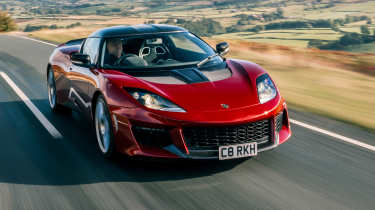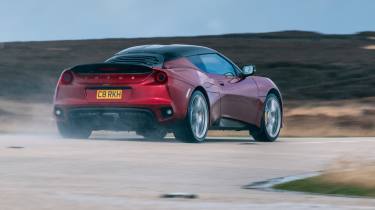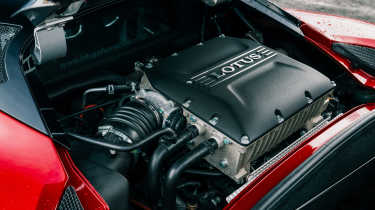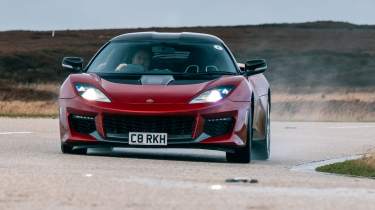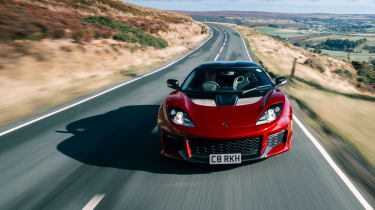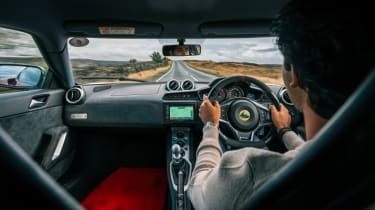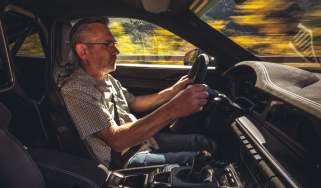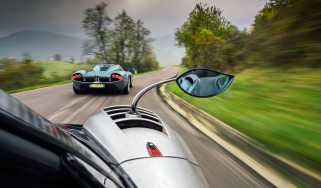Lotus Evora (2009 - 2021) review: an everyday sports car for hot hatch money
It may not have sold in huge numbers, but the Evora is the everyday Lotus that’s also a sublime steer
To say the original Lotus Evora was well received would be an understatement – in 2009, it was evo Car of the Year, fending off the 997.2 Porsche 911 GT3 and the Noble M600. Built around a bonded aluminium structure similar to the Lotus Elise’s, the Evora used 3.5-litre Toyota V6 power and packed 2+2 seating into its mid-engined layout. It gave Lotus the high-end model it had lacked since the Esprit had disappeared in 2004, and that the Europa S hadn’t been able to fill.
A supercharged Evora S arrived in 2010, but it took the appointment of Jean-Marc Gales in 2014, with a solid marketing plan and a focus on quality improvements, for the car to flourish. The Evora 400 came along in 2015 to replace the S, and in 2016, Lotus launched the Sport 410, with a power increase, less weight and a sharper chassis – effectively the Cayman GT4 of the Evora range.
> Lotus Emira Turbo SE 2025 review – a rebranded sports car with detail tweaks
Development of the Evora didn’t stop with the Sport 410, with the GT430 launched in 2017 and later that year the GT430 Sport and GTSport 410, all with large rear wings and similar weight savings to the Sport 410. In 2020, not long before the Evora went off sale, the company launched the GT410, a more road-biased model with softer suspension settings, less extreme tyres and more creature comforts. The Evora was eventually replaced by the Emira in 2022.
More reviews
Group tests
In-depth reviews
Reviews
There’s no definitive ‘best’ model in the Evora range, but the Sport 410 is representative of the progress Lotus made over the years, retaining stand-out qualities such as ride, handling and steering, yet making significant leaps in terms of quality and reliability. It’s a fine sports car, and one that today you can pick up for less money than some hot hatchbacks.
For
- Steering and ride are still among the best
- V6 is thrilling, powerful and reliable
- Styling still looks unique, with a racy edge in Sport 410 form
Against
- Can’t quite match some contemporaries for cabin quality
- Relationship of the controls isn’t quite at Porsche levels
- Air con and infotainment could be deleted, so buy carefully
Price
£45,000 - £55,000 (value today)
evo verdict
The Evora Sport 410 showed that there was some room in the Evora platform for a more focused driving experience, without chipping away at the car’s fundamental qualities or usability. A Porsche Cayman GT4 offers a more polished experience, but the Sport 410 still holds its own in terms of steering feel and ride quality, while the supercharged V6 engine is never less than exciting to spin to the limiter. The Sport 410, and the Evora as a whole, still has the chops to give even the later Lotus Emira a hard time.
Engine, gearbox and technical highlights
- Supercharged, Toyota-derived 3.5-litre V6 produced 410bhp
- Weight-saving measures included carbon panels; more than 70kg saved
- Cup 2 tyres and Bilstein/Eibach suspension improved cornering performance
Like all Evoras, the Sport 410 used a variant of the Toyota-sourced 3.5-litre V6, and like most, its engine was tweaked by Lotus, with the addition of a supercharger resulting in an output somewhat greater than you’d find in a common-or-garden Toyota saloon.
In the case of the Sport 410, output was an even 410bhp (hence the name) at 7000rpm, with torque of 302lb ft at half those revs, with useful shove from idle thanks to that supercharger doing its work wherever you are in the rev range. It’s a less exotic powerplant than you might find in, say, a six-cylinder Porsche Cayman, but you only need to look at the performance figures to realise it’s effective. A six-speed manual gearbox was standard, and an automatic optional, though understandably not many buyers opted for the latter.
The Evora used a bonded aluminium tub, in a manner similar to that introduced with the Elise in 1996, but key to the Sport 410’s performance was a series of weight-saving measures, including ditching the rear seats, replacing some components with carbonfibre (most notably the engine cover) and installing a little less sound deadening (5.5kg saved there) for a 70kg diet. Buyers could also delete the air conditioning (8.5kg) and infotainment system (4.3kg) for further savings. There’s no definitive number, but something in the region of 1325kg is about right – pretty good when even the naturally aspirated Evora of 2009 came in at 1382kg.
Alongside the weight savings, Sport 410s got a set of Bilstein dampers (which were 25 per cent firmer up front, 20 per cent at the rear) and sat 5mm lower on Eibach springs. The forged wheels – another weight-saving measure – came wrapped in Michelin Pilot Sport Cup 2 tyres.
Model |
Power |
Torque |
0-62mph |
Top speed |
| Lotus Evora Sport 410 | 410bhp | 302lb ft | 4.2sec | 190mph |
Driver’s note
‘The relationship between the controls, particularly throttle, clutch and gearshift, isn't as intuitive as in the Porsche Cayman GT4’ – Yousuf Ashraf, senior staff writer, drove the Evora Sport 410 on evo’s six-cylinder sports car test in issue 339
Performance, ride and handling
- Steering and ride quality are still top-drawer stuff
- Plenty of grip, and a chassis that never feels like it’s going to bite
- Exciting performance and exhaust note, but throttle response could be sharper
If the Evora’s cabin no longer feels fresh and its styling is less exotic than that of the Emira, the driving experience hasn’t dated a day. And in another decade or two, or five, the Evora’s ride and steering in particular will still be excellent; both are better, if anything, than the current Lotus sports car’s.
Despite the Sport 410 getting a firmer set-up than other variants, it loses little in terms of pliancy. It can feel firm at lower speeds but flows with the road at a faster pace, and never feels like it’s finding the limits of its wheel travel, nor leaves the driver with a sense things are getting out of hand. The steering, meanwhile, remains among the best of any car built this century: ideal weighting, keen but not hyperactive response, and a constant but not overwhelming stream of information to the fingertips.
The Sport 410’s balance is precise rather than playful but the chassis is easy to trust. And easy pace is always there for the taking: the trumpet-like note of the 410’s valved exhaust isn’t to all tastes but it’s certainly exciting, and this is a very quick car – 0-62mph takes 4.2 seconds, and it’ll do a near-supercar-like 190mph flat out. If there’s a limitation to the drivetrain it’s that the gearshift isn’t quite as slick as you’ll find in a Porsche (though it’s nicely tactile), and there’s some input delay in blips of the throttle, needing a bigger prod than you might expect for a nice rev-matched downchange.
Driver’s note
‘Once you get the speed up it starts to come together, the ride settles down and it flows better. It sounds great too, much more exciting than an Emira, especially from the outside. Although I bumped into the limiter a few times when revving it out, because it feels like there should be more to come after 7000rpm.’ – Yousuf Ashraf, senior staff writer, drove the Evora Sport 410 on evo’s six-cylinder sports car test in issue 339
MPG and running costs
- 30mpg economy and 300+ miles on a tank
- Post-2017 VED shouldn’t sting too much
- Generally reliable and not too hard on consumables
An official 29.1mpg doesn’t sound too bad for a car of the Sport 410’s performance, and if you ignore the ‘low fuel’ light and take things easy, there’s the potential to squeeze 380 miles from a tank at that kind of economy. More realistically, you’re looking at fills after 300 miles or so in regular use, and owners seem to be getting figures in the high 20s to low 30s, so the official number is proving reasonably accurate. Naturally, that figure will soon tumble on a fast B-road drive or trackday.
CO2 was quoted as 225g/km back in 2016, which means a yearly tax bill of £430, but any Sport 410s registered from April 2017 onwards attract only £195 a year in VED. Long-term running costs shouldn’t be too punishing either – Evoras of all types are proving mechanically reliable (thanks, Toyota). Ensuring work from the handful of recalls has been carried out should reduce potential issues further.
What to look out for
Lotuses aren’t always considered to be the most reliable of cars, but with relatively simple underpinnings and a dependable Toyota V6 at its core, the Evora isn’t as bad as some might think. The vast majority of owners report only minor niggles, even on high-mileage cars: glitches with the electronics can cause door-lock issues and rare ECU problems; keep an eye out for ill-fitting trim inside and out, and note that the Recaro seats tend to show signs of wear earlier than you might expect.
The Evora’s mechanical components are generally very reliable. Early cars had issues with the clutch master cylinder, but the later Evora S item can be installed to rectify this. Transmission noise from poor-quality clutch bearings is possible and, on the supercharged Evora S (345bhp) oil line failures have occurred on early cars (2010 to August 2011). The vast majority of these issues should already have been rectified under warranty or recall, however, so check the car’s history when buying.
Otherwise, you’re only likely to experience the odd electrical niggle, or problems relating to poor maintenance or heavy track use. Early Evoras had a reputation for chewing through tyres (a new set after 10,000 miles wasn’t unusual) but later cars like the 410 seem to use them more gently, and the car’s light weight should keep consumables consumption to a minimum.
Interior and technology
- Interior styling is looking a little dated, but quality is pretty good
- Cab-forward driving position gives you a great view out
- Air con and infotainment were both options, so some cars do without
As one of the later Evora models, the Sport 410 benefits from some of the quality and usability improvements that made it into the platform over the model’s lifespan. The more recent Emira has attracted praise for its high-quality cabin, but much of the groundwork was laid here – the driving environment is just a little more stark than in the newer car.
Climb aboard and two things will strike you immediately. One is the feeling of sitting almost on top of the front axle, given the wraparound windscreen, short dashboard, and the car’s cab-forward layout. The other is that there’s next to no view through the rear-view mirror, thanks to the Sport’s carbon engine cover; you’ll be relying on the side mirrors, though to be fair to the Sport, even Evoras with a glass cover don’t have brilliant rearward visibility. The driving position is fundamentally good and the lightweight bucket seats are surprisingly comfortable once you’ve settled in.
Sport models ditched the regular Evora’s vestigial rear seats, and instead get a kind of shelf, which bolsters the car’s luggage-carrying abilities. When new, infotainment was optional. Without it, you got a nice 410-stamped metal plate; with it, a double-DIN touchscreen that now feels a bit dated, but is easy enough to upgrade. Likewise, air con was optional (you could save 8.5kg for binning it), but is one of those things you’ll probably want to seek out unless the car’s going to spend its life on track.
Prices and buying options
The Evora didn’t sell in huge numbers, so there are limited examples available in the classifieds, particularly from the early years of production. The oldest cars, with 60,000-plus miles on the odometer, are priced from just under £25,000, but if you’d like fewer miles and more desirable options, £30,000 should be more than enough. S spec will add £5000 or so. Facelift cars, which were all supercharged and started with the 400bhp Evora 400 in 2015, kick off from just shy of £50,000.
From a starting price of £82,000 in 2016, the range-topping Evora Sport 410 has fallen to between £45,000 and £55,000 on today’s used market. That’s both admirably slow depreciation, yet also pretty good value given the Evora’s performance. Today’s V6-powered Emira starts at £96,500 and, other than more exotic styling and a fancier cabin, it doesn’t get you a lot more car – the two share an engine, since Lotus is still using a supercharged Toyota V6, and the Sport 410 is actually a tenth quicker to 62mph, no doubt thanks to its lighter weight.
It also compares favourably with sports cars of similar ethos on the used market. It splits the average prices for a fellow British sports car, the TVR T350C (while being a lot more dynamically capable), and the 981 Porsche Cayman GT4. The GT4 admittedly has an edge over even the Evora on driver appeal, so it’d be tempting to rustle up the extra cash somehow, but the 410 really isn’t far behind.
Most Evoras on the market will be similarly specified, aside from exterior colour and the fact that, when new, both air conditioning and an infotainment system were no-cost options. Most buyers went for both as a result, but cars without will feel a little more sparse. The key feature to look for is whether the last owner has fitted suitable tyres – the Sport originally wore Michelin Pilot Sport Cup 2s, and its suspension set-up was designed to work best with a slightly more aggressive tyre like this (the more road-biased, softer-riding GT410 came on Michelin Pilot Sport 4 S tyres).
What we thought
This road in south Wales is as lumpy as a sack of spuds, but not much of that turmoil is reaching us through the seats. ‘My car was terrible when I came down here for a recce earlier,’ says photographer Aston Parrott, slightly bemused. The Evora feels astonishingly good, as if the road has been resurfaced in the last couple of hours. Still got it, then.
The Evora’s ride is still outstanding because, along with power-to-weight ratio and torque-to-grip, it’s one of those characteristics that doesn’t age. In fact, the general trend towards firmer cars means that in 2025 the Evora feels even more supple than when it was launched in 2009.
It’s almost a lost art. The Alpine A110 is the only modern sports car that shares the Lotus approach to lightweight build and an absorbent ride, but there’s a key Lotus characteristic Alpine hasn’t yet delivered: connected, talkative, engaging steering. The Evora had great steering right from the start. I remember on the launch leaving the hotel and being struck by its quality before I’d got to the end of the driveway. It’s another feature that’s more impressive now because it’s hydraulically assisted, a rarity today. Electrically assisted systems have made great strides but there’s still something more natural and nuanced about a hydraulic system. It’s why McLaren uses hydraulic and why it’s been retained for the Emira.
With that memory of delicacy and subtlety in my mind, I was a bit surprised to discover that the steering of this beautiful Evora is pretty heavy initially. It’s a 2014 car, one of the last naturally aspirated versions: a Sports Racer model, with wheels an inch bigger than the original – 18-inch front, 19-inch rear – shod with appropriately upsized tyres. Maybe that explains the low-speed heft, though it’s great to discover that as soon as the speed picks up, the steering is as bright and biddable as the original’s.
Like the Elise S2’s 1.8-litre in-line four, the V6 was a fruit of Lotus’s good relationship with Toyota. The all-aluminium, 24-valve V6 ‘2GR-FE’ came from the US-market RAV‑4, for the favourable position of its engine mounts, and gained a Lotus-designed intake and Lotus ‘T6’ ECU so that it would interface with the Lotus instruments, stability controls, immobiliser and the like. There was a physical issue to overcome too: despite its many applications within the Toyota group, not one mated the V6 to a manual gearbox.
After a trawl through the Toyota range, Lotus selected the six-speed ’box from the Avensis diesel for its high torque capacity and then adapted it to fit the V6, adding an AP clutch and flywheel. However, being designed for a low-rev diesel, the inherited gearing was quite long, so with Toyota’s blessing Lotus made some new gears, creating the Sports Ratio option. First and second were retained but the other gears were shortened, culminating in a sixth giving 27mph per 1000rpm versus the original’s leggy 36.4mph.
The gearshift on this car is tight and sweet-shifting with a lovely clackety, Elise-like, metal-on-metal report, while perfect pedal spacing for heel and toe encourages you to finesse your downshifts. It’s hard to imagine the Evora without these bespoke ratios. Even with them, every now and again there’s a corner that makes the gap between second and third feel a fraction big, a corner where second would interrupt the flow with a burst of high revs but third gear would have the V6 digging a fraction deep.
The flat-plane-crank V8 that Lotus had designed and developed for the Esprit was ruled out for the Evora because of emissions and also because it was felt that the natural engine for this part of the market was a six-cylinder. It also had to be an off-the-shelf engine; the total budget to make the Evora was said to be a tenth of what a large car maker would have spent. The time scale demanded it too.
One of the secrets of the Evora’s success was its bonded and riveted aluminium chassis which, with the added strength of a roof, bonded-in screen and extra bulkheads, was 2.5 times stiffer than the Elise’s. This gave an excellent platform for the suspension to work from and the suspension hardware itself played its part. Lotus had invested in forged aluminium wishbones, intending to use them first for the new Esprit. Sadly, the closest they got to that was when early Evora prototypes began winter testing in Arjeplog disguised in old Esprit bodies.
The Evora is one of those rare cars that seems to enjoy all types of road, and there’s a wide selection here in south Wales. You can place it perfectly on a smooth road but it can also declaw a really difficult surface. Its steering is the same, in that its stream of feedback lets you know what’s going on at the wheels but precision is unaffected. It does feel very Elise-like in character, going from being quite heavy initially, to quickly right once the speed picks up, to becoming chattery on a bumpy road, while the feedback and connection allow you to put the Evora just where you want it.
It’s such a satisfying car for such a lot of the time. You can relax into it, stroke the V6 along, short-shifting, or you can pick up the pace, lean into the steering and work the grip and the engine. Either way, the Evora feels poised and polished. The pace really doesn’t matter.
In the dry, the chassis doesn’t want to do anything heroic. You might sense the front just starting to slip but there isn’t an excess of power and torque, so even with the traction control off, the back end isn’t going anywhere without severe provocation. Especially not this one, which is wearing Michelin Pilot Sport 4 Ss rather than the original Pirellis. – John Barker, evo issue 302
Lotus Evora specs
Model |
evo rating |
Price |
Kerb weight |
Power |
0-62mph |
| Lotus Evora Sport 410 | 4.5 | £45-55k | 1325kg | 410bhp | 4.2sec |
| TVR T350C | 4.5 | £30-45k | 1187kg | 350bhp | 4.7sec |
| Porsche 981 Cayman GT4 | 5.0 | £55-65k | 1340kg | 380bhp | 4.4sec |
| BMW Z4 M Coupe | 4.5 | £15-25k | 1420kg | 338bhp | 5.0sec |
